New Ways to Strategic Talent Management: A Study on Marks & Spencer
VerifiedAdded on 2023/06/15
|29
|5537
|276
Report
AI Summary
This report explores innovative approaches to strategic talent management, particularly within the context of Marks and Spencer. It begins by defining talent management and its importance in achieving organizational goals. The research employs both inductive and deductive research approaches, along with quantitative and qualitative research methods, to identify key strategies such as understanding organizational goals, prioritizing employee needs, proactive planning, and setting clear objectives. The literature review covers talent management frameworks, retention strategies, career management, HR planning, and talent development. The report concludes with recommendations for improving talent management practices, emphasizing the need for continuous development and adaptation to changing business environments. This document is available on Desklib, a platform offering a wide range of study tools and resources for students.
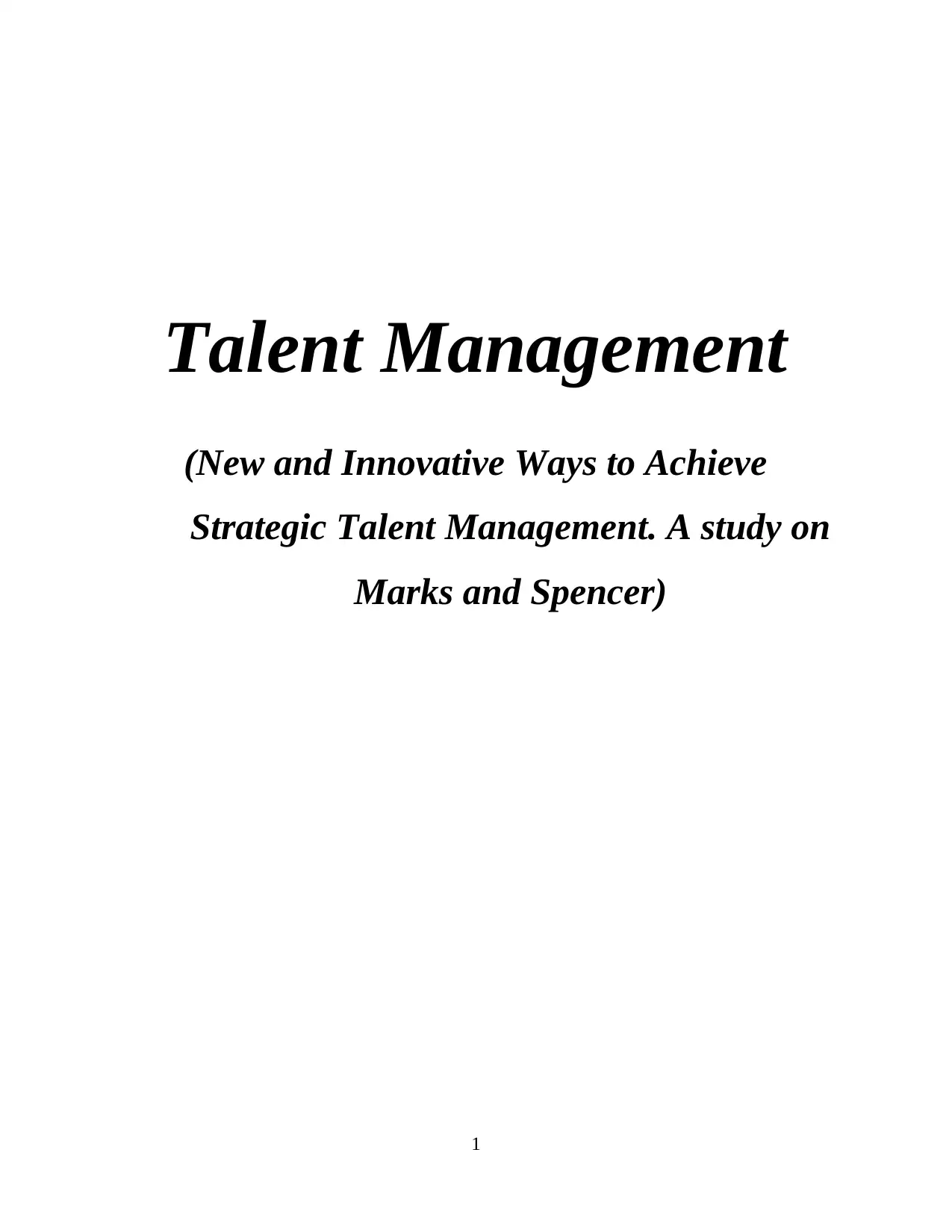
Talent Management
(New and Innovative Ways to Achieve
Strategic Talent Management. A study on
Marks and Spencer)
1
(New and Innovative Ways to Achieve
Strategic Talent Management. A study on
Marks and Spencer)
1
Paraphrase This Document
Need a fresh take? Get an instant paraphrase of this document with our AI Paraphraser
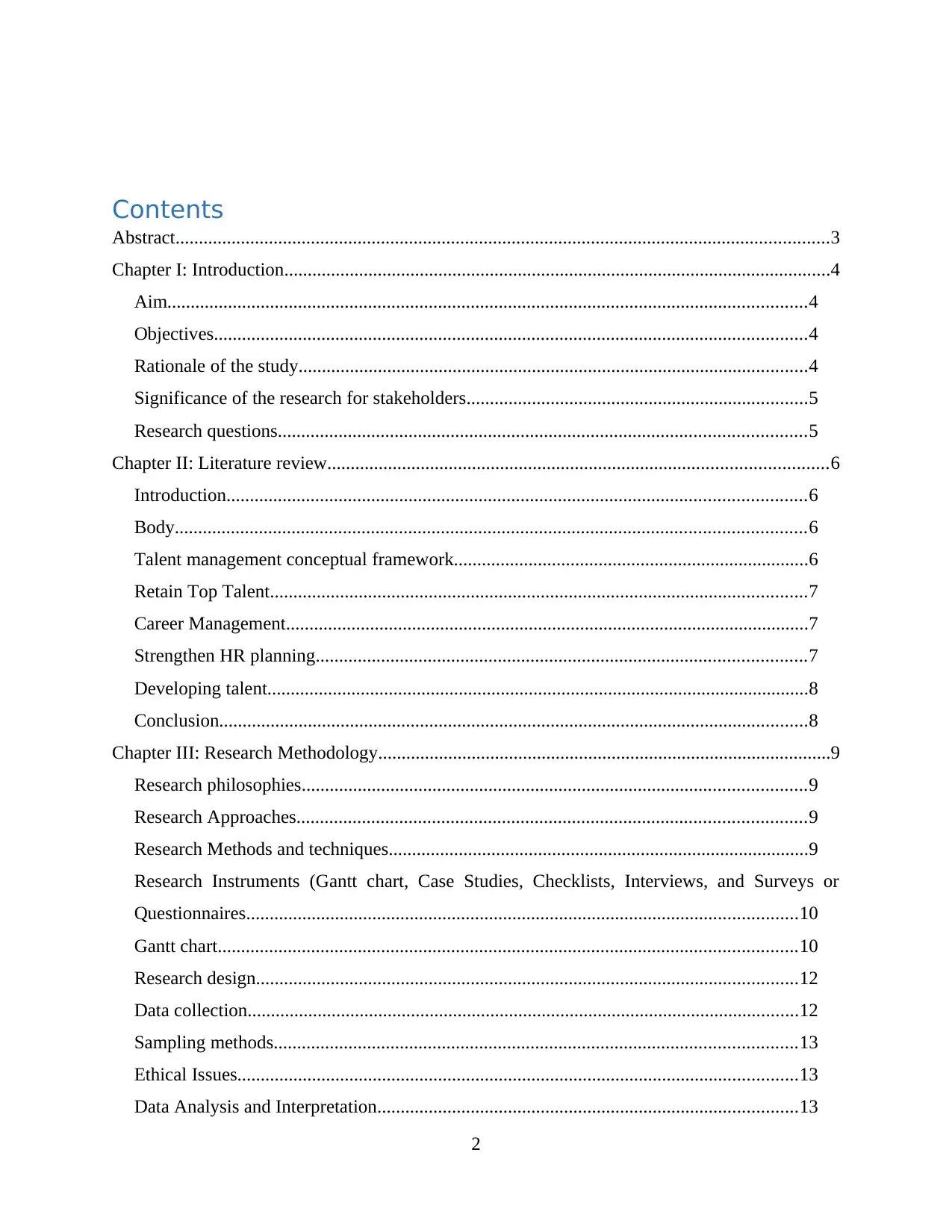
Contents
Abstract............................................................................................................................................3
Chapter I: Introduction.....................................................................................................................4
Aim.........................................................................................................................................4
Objectives...............................................................................................................................4
Rationale of the study.............................................................................................................4
Significance of the research for stakeholders.........................................................................5
Research questions.................................................................................................................5
Chapter II: Literature review...........................................................................................................6
Introduction............................................................................................................................6
Body.......................................................................................................................................6
Talent management conceptual framework............................................................................6
Retain Top Talent...................................................................................................................7
Career Management................................................................................................................7
Strengthen HR planning.........................................................................................................7
Developing talent....................................................................................................................8
Conclusion..............................................................................................................................8
Chapter III: Research Methodology.................................................................................................9
Research philosophies............................................................................................................9
Research Approaches.............................................................................................................9
Research Methods and techniques..........................................................................................9
Research Instruments (Gantt chart, Case Studies, Checklists, Interviews, and Surveys or
Questionnaires......................................................................................................................10
Gantt chart............................................................................................................................10
Research design....................................................................................................................12
Data collection......................................................................................................................12
Sampling methods................................................................................................................13
Ethical Issues........................................................................................................................13
Data Analysis and Interpretation..........................................................................................13
2
Abstract............................................................................................................................................3
Chapter I: Introduction.....................................................................................................................4
Aim.........................................................................................................................................4
Objectives...............................................................................................................................4
Rationale of the study.............................................................................................................4
Significance of the research for stakeholders.........................................................................5
Research questions.................................................................................................................5
Chapter II: Literature review...........................................................................................................6
Introduction............................................................................................................................6
Body.......................................................................................................................................6
Talent management conceptual framework............................................................................6
Retain Top Talent...................................................................................................................7
Career Management................................................................................................................7
Strengthen HR planning.........................................................................................................7
Developing talent....................................................................................................................8
Conclusion..............................................................................................................................8
Chapter III: Research Methodology.................................................................................................9
Research philosophies............................................................................................................9
Research Approaches.............................................................................................................9
Research Methods and techniques..........................................................................................9
Research Instruments (Gantt chart, Case Studies, Checklists, Interviews, and Surveys or
Questionnaires......................................................................................................................10
Gantt chart............................................................................................................................10
Research design....................................................................................................................12
Data collection......................................................................................................................12
Sampling methods................................................................................................................13
Ethical Issues........................................................................................................................13
Data Analysis and Interpretation..........................................................................................13
2
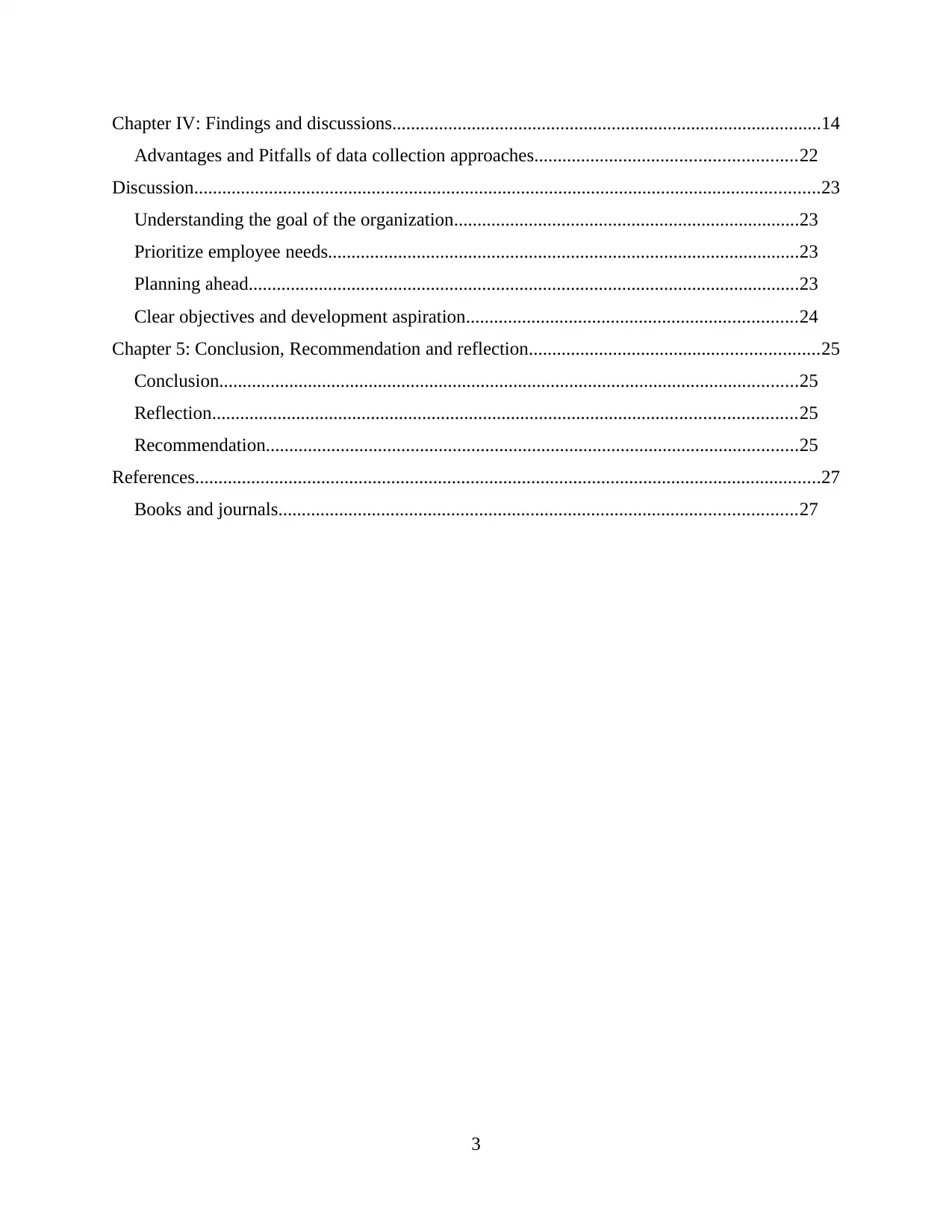
Chapter IV: Findings and discussions............................................................................................14
Advantages and Pitfalls of data collection approaches........................................................22
Discussion......................................................................................................................................23
Understanding the goal of the organization..........................................................................23
Prioritize employee needs.....................................................................................................23
Planning ahead......................................................................................................................23
Clear objectives and development aspiration.......................................................................24
Chapter 5: Conclusion, Recommendation and reflection..............................................................25
Conclusion............................................................................................................................25
Reflection.............................................................................................................................25
Recommendation..................................................................................................................25
References......................................................................................................................................27
Books and journals...............................................................................................................27
3
Advantages and Pitfalls of data collection approaches........................................................22
Discussion......................................................................................................................................23
Understanding the goal of the organization..........................................................................23
Prioritize employee needs.....................................................................................................23
Planning ahead......................................................................................................................23
Clear objectives and development aspiration.......................................................................24
Chapter 5: Conclusion, Recommendation and reflection..............................................................25
Conclusion............................................................................................................................25
Reflection.............................................................................................................................25
Recommendation..................................................................................................................25
References......................................................................................................................................27
Books and journals...............................................................................................................27
3
⊘ This is a preview!⊘
Do you want full access?
Subscribe today to unlock all pages.

Trusted by 1+ million students worldwide
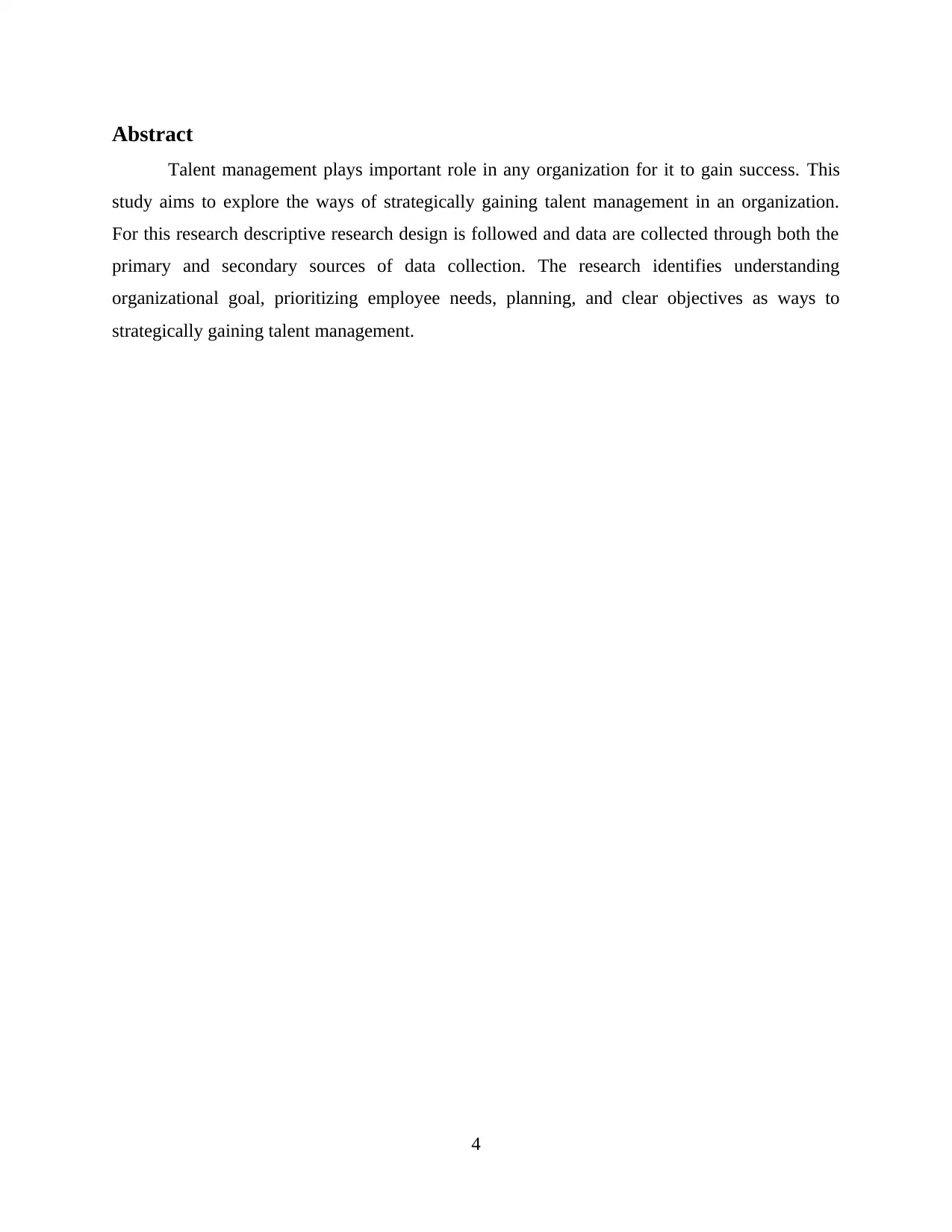
Abstract
Talent management plays important role in any organization for it to gain success. This
study aims to explore the ways of strategically gaining talent management in an organization.
For this research descriptive research design is followed and data are collected through both the
primary and secondary sources of data collection. The research identifies understanding
organizational goal, prioritizing employee needs, planning, and clear objectives as ways to
strategically gaining talent management.
4
Talent management plays important role in any organization for it to gain success. This
study aims to explore the ways of strategically gaining talent management in an organization.
For this research descriptive research design is followed and data are collected through both the
primary and secondary sources of data collection. The research identifies understanding
organizational goal, prioritizing employee needs, planning, and clear objectives as ways to
strategically gaining talent management.
4
Paraphrase This Document
Need a fresh take? Get an instant paraphrase of this document with our AI Paraphraser
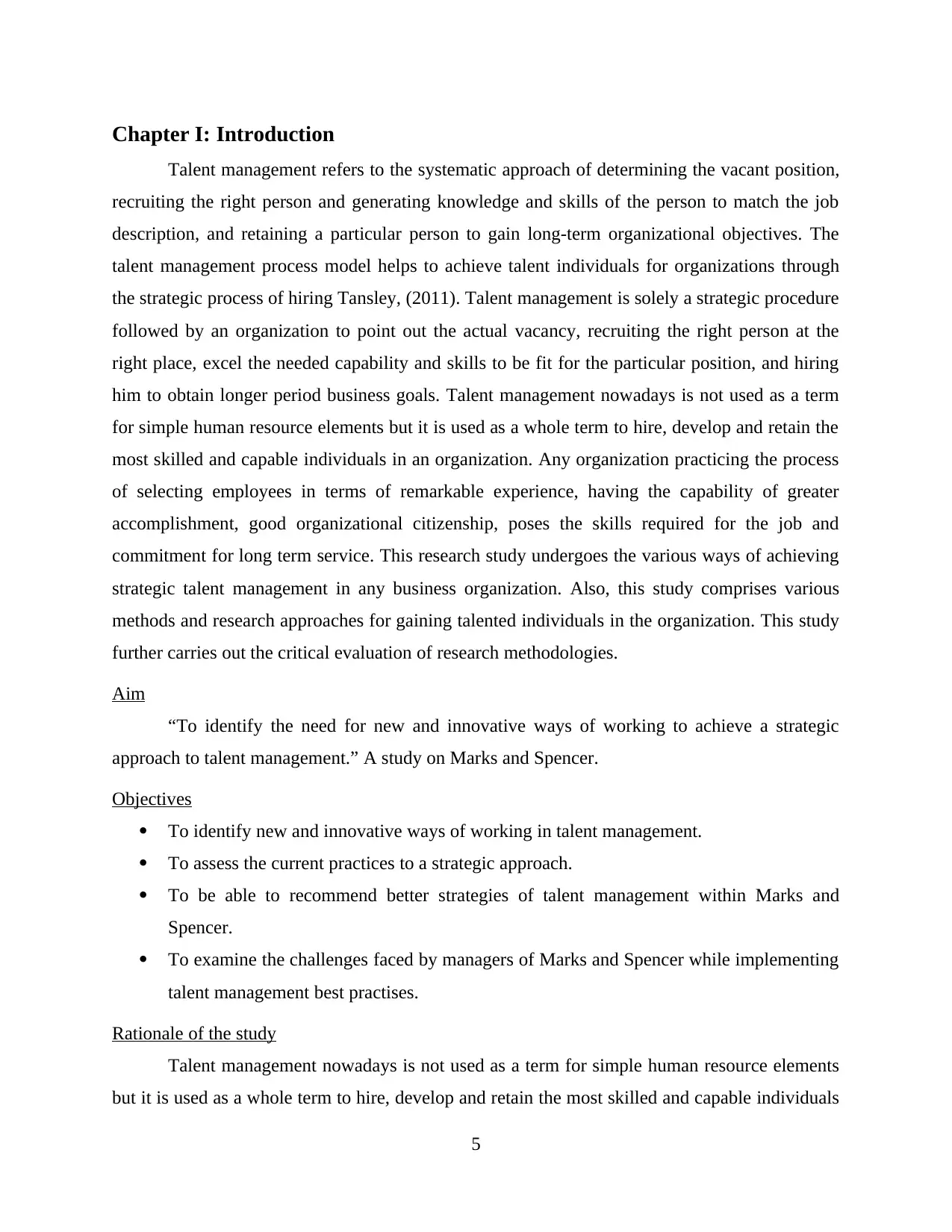
Chapter I: Introduction
Talent management refers to the systematic approach of determining the vacant position,
recruiting the right person and generating knowledge and skills of the person to match the job
description, and retaining a particular person to gain long-term organizational objectives. The
talent management process model helps to achieve talent individuals for organizations through
the strategic process of hiring Tansley, (2011). Talent management is solely a strategic procedure
followed by an organization to point out the actual vacancy, recruiting the right person at the
right place, excel the needed capability and skills to be fit for the particular position, and hiring
him to obtain longer period business goals. Talent management nowadays is not used as a term
for simple human resource elements but it is used as a whole term to hire, develop and retain the
most skilled and capable individuals in an organization. Any organization practicing the process
of selecting employees in terms of remarkable experience, having the capability of greater
accomplishment, good organizational citizenship, poses the skills required for the job and
commitment for long term service. This research study undergoes the various ways of achieving
strategic talent management in any business organization. Also, this study comprises various
methods and research approaches for gaining talented individuals in the organization. This study
further carries out the critical evaluation of research methodologies.
Aim
“To identify the need for new and innovative ways of working to achieve a strategic
approach to talent management.” A study on Marks and Spencer.
Objectives
To identify new and innovative ways of working in talent management.
To assess the current practices to a strategic approach.
To be able to recommend better strategies of talent management within Marks and
Spencer.
To examine the challenges faced by managers of Marks and Spencer while implementing
talent management best practises.
Rationale of the study
Talent management nowadays is not used as a term for simple human resource elements
but it is used as a whole term to hire, develop and retain the most skilled and capable individuals
5
Talent management refers to the systematic approach of determining the vacant position,
recruiting the right person and generating knowledge and skills of the person to match the job
description, and retaining a particular person to gain long-term organizational objectives. The
talent management process model helps to achieve talent individuals for organizations through
the strategic process of hiring Tansley, (2011). Talent management is solely a strategic procedure
followed by an organization to point out the actual vacancy, recruiting the right person at the
right place, excel the needed capability and skills to be fit for the particular position, and hiring
him to obtain longer period business goals. Talent management nowadays is not used as a term
for simple human resource elements but it is used as a whole term to hire, develop and retain the
most skilled and capable individuals in an organization. Any organization practicing the process
of selecting employees in terms of remarkable experience, having the capability of greater
accomplishment, good organizational citizenship, poses the skills required for the job and
commitment for long term service. This research study undergoes the various ways of achieving
strategic talent management in any business organization. Also, this study comprises various
methods and research approaches for gaining talented individuals in the organization. This study
further carries out the critical evaluation of research methodologies.
Aim
“To identify the need for new and innovative ways of working to achieve a strategic
approach to talent management.” A study on Marks and Spencer.
Objectives
To identify new and innovative ways of working in talent management.
To assess the current practices to a strategic approach.
To be able to recommend better strategies of talent management within Marks and
Spencer.
To examine the challenges faced by managers of Marks and Spencer while implementing
talent management best practises.
Rationale of the study
Talent management nowadays is not used as a term for simple human resource elements
but it is used as a whole term to hire, develop and retain the most skilled and capable individuals
5
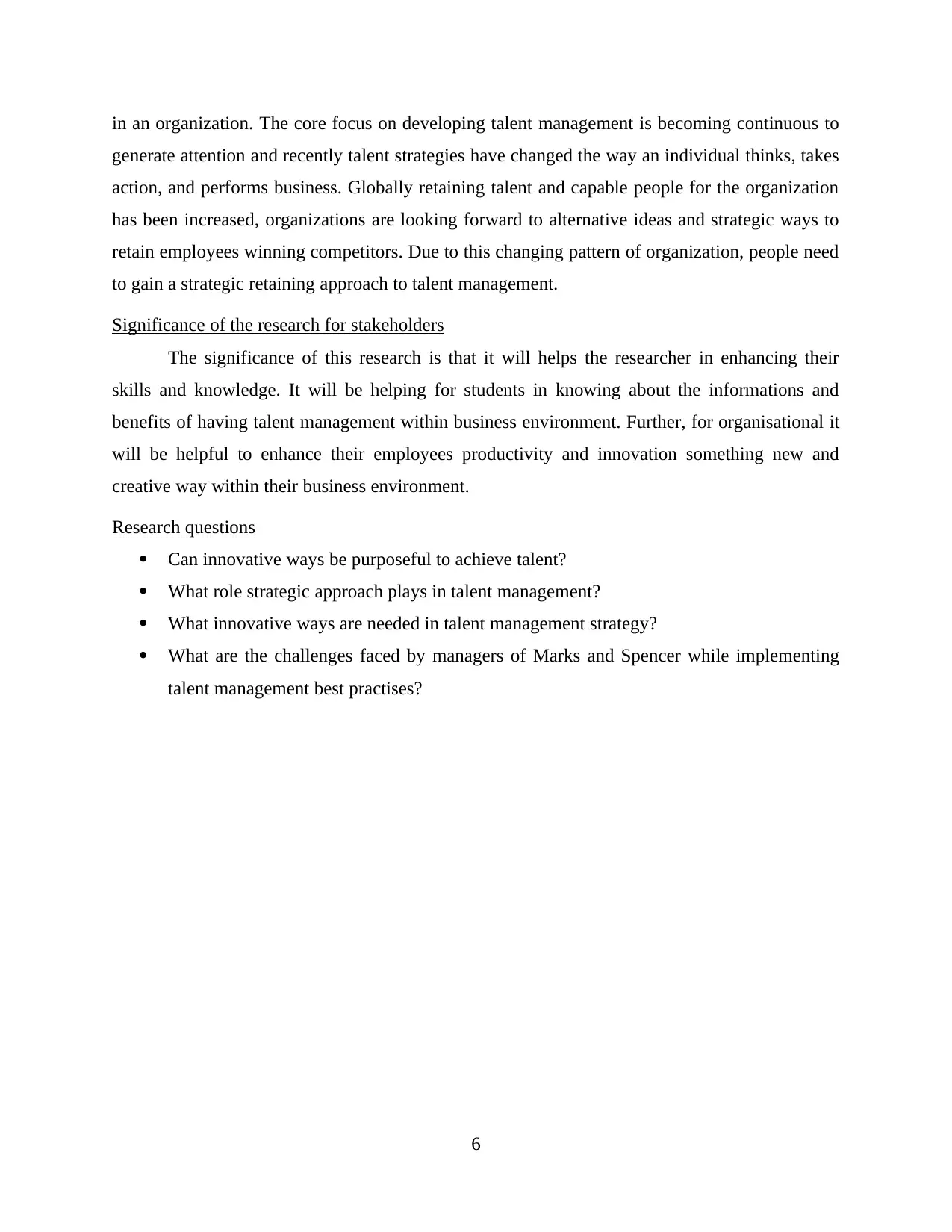
in an organization. The core focus on developing talent management is becoming continuous to
generate attention and recently talent strategies have changed the way an individual thinks, takes
action, and performs business. Globally retaining talent and capable people for the organization
has been increased, organizations are looking forward to alternative ideas and strategic ways to
retain employees winning competitors. Due to this changing pattern of organization, people need
to gain a strategic retaining approach to talent management.
Significance of the research for stakeholders
The significance of this research is that it will helps the researcher in enhancing their
skills and knowledge. It will be helping for students in knowing about the informations and
benefits of having talent management within business environment. Further, for organisational it
will be helpful to enhance their employees productivity and innovation something new and
creative way within their business environment.
Research questions
Can innovative ways be purposeful to achieve talent?
What role strategic approach plays in talent management?
What innovative ways are needed in talent management strategy?
What are the challenges faced by managers of Marks and Spencer while implementing
talent management best practises?
6
generate attention and recently talent strategies have changed the way an individual thinks, takes
action, and performs business. Globally retaining talent and capable people for the organization
has been increased, organizations are looking forward to alternative ideas and strategic ways to
retain employees winning competitors. Due to this changing pattern of organization, people need
to gain a strategic retaining approach to talent management.
Significance of the research for stakeholders
The significance of this research is that it will helps the researcher in enhancing their
skills and knowledge. It will be helping for students in knowing about the informations and
benefits of having talent management within business environment. Further, for organisational it
will be helpful to enhance their employees productivity and innovation something new and
creative way within their business environment.
Research questions
Can innovative ways be purposeful to achieve talent?
What role strategic approach plays in talent management?
What innovative ways are needed in talent management strategy?
What are the challenges faced by managers of Marks and Spencer while implementing
talent management best practises?
6
⊘ This is a preview!⊘
Do you want full access?
Subscribe today to unlock all pages.

Trusted by 1+ million students worldwide
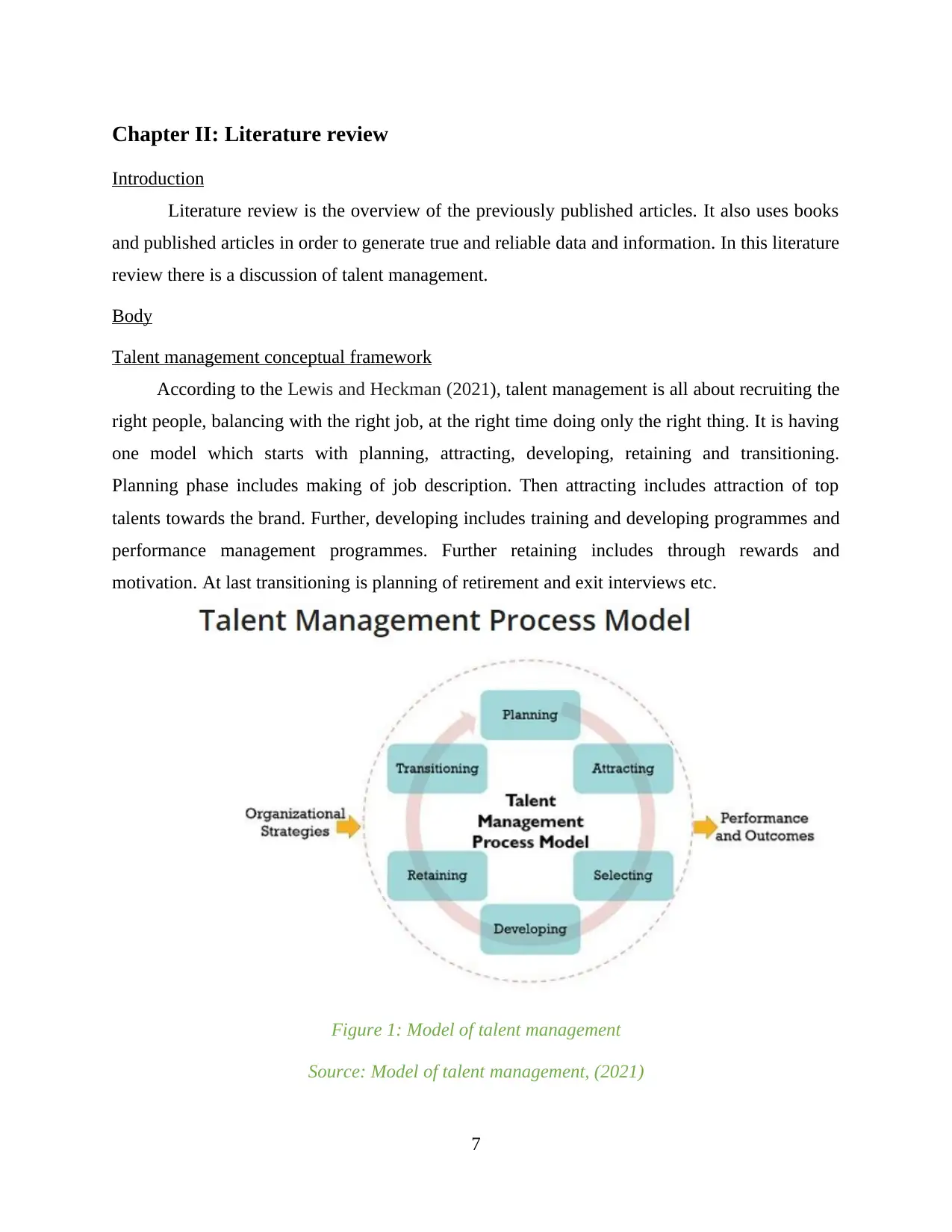
Chapter II: Literature review
Introduction
Literature review is the overview of the previously published articles. It also uses books
and published articles in order to generate true and reliable data and information. In this literature
review there is a discussion of talent management.
Body
Talent management conceptual framework
According to the Lewis and Heckman (2021), talent management is all about recruiting the
right people, balancing with the right job, at the right time doing only the right thing. It is having
one model which starts with planning, attracting, developing, retaining and transitioning.
Planning phase includes making of job description. Then attracting includes attraction of top
talents towards the brand. Further, developing includes training and developing programmes and
performance management programmes. Further retaining includes through rewards and
motivation. At last transitioning is planning of retirement and exit interviews etc.
Figure 1: Model of talent management
Source: Model of talent management, (2021)
7
Introduction
Literature review is the overview of the previously published articles. It also uses books
and published articles in order to generate true and reliable data and information. In this literature
review there is a discussion of talent management.
Body
Talent management conceptual framework
According to the Lewis and Heckman (2021), talent management is all about recruiting the
right people, balancing with the right job, at the right time doing only the right thing. It is having
one model which starts with planning, attracting, developing, retaining and transitioning.
Planning phase includes making of job description. Then attracting includes attraction of top
talents towards the brand. Further, developing includes training and developing programmes and
performance management programmes. Further retaining includes through rewards and
motivation. At last transitioning is planning of retirement and exit interviews etc.
Figure 1: Model of talent management
Source: Model of talent management, (2021)
7
Paraphrase This Document
Need a fresh take? Get an instant paraphrase of this document with our AI Paraphraser
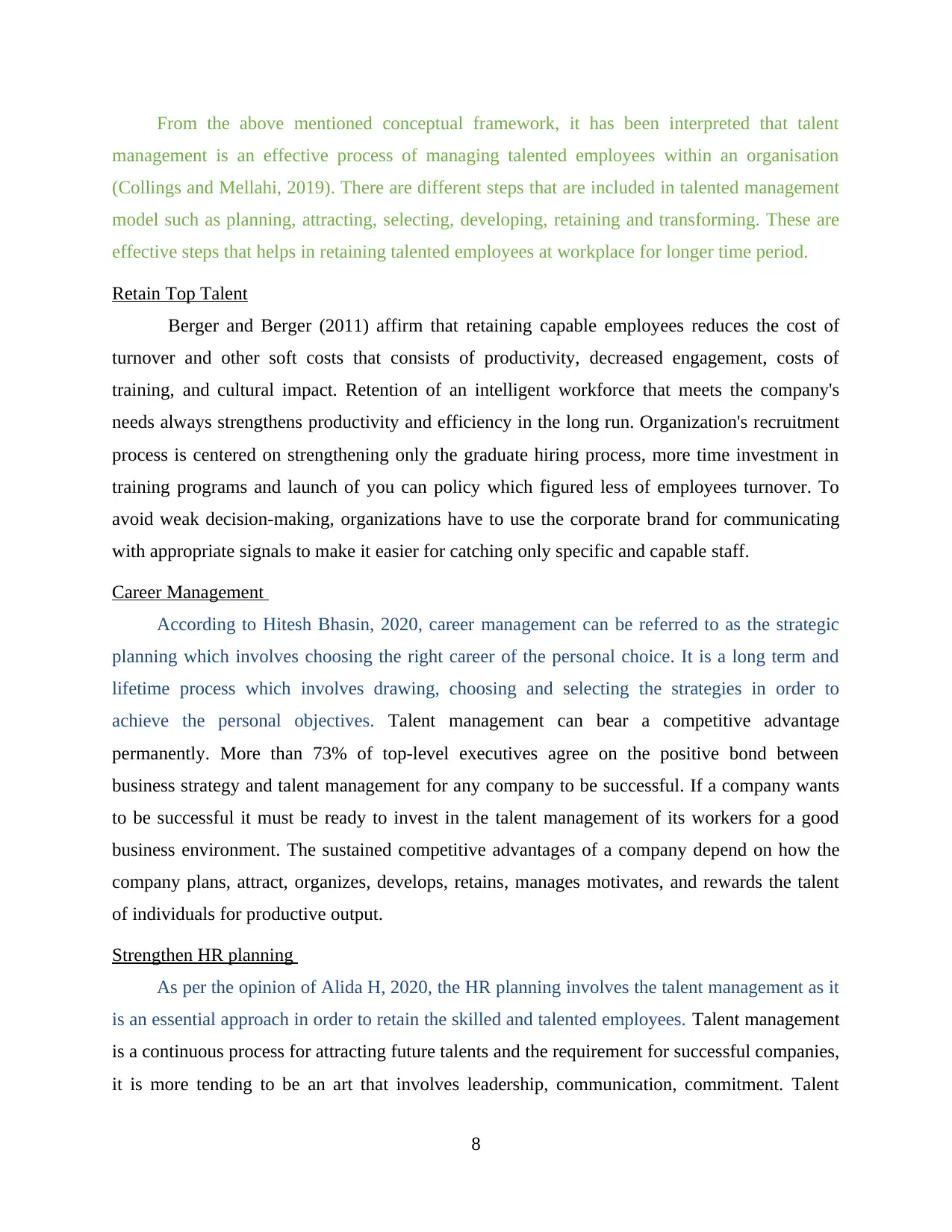
From the above mentioned conceptual framework, it has been interpreted that talent
management is an effective process of managing talented employees within an organisation
(Collings and Mellahi, 2019). There are different steps that are included in talented management
model such as planning, attracting, selecting, developing, retaining and transforming. These are
effective steps that helps in retaining talented employees at workplace for longer time period.
Retain Top Talent
Berger and Berger (2011) affirm that retaining capable employees reduces the cost of
turnover and other soft costs that consists of productivity, decreased engagement, costs of
training, and cultural impact. Retention of an intelligent workforce that meets the company's
needs always strengthens productivity and efficiency in the long run. Organization's recruitment
process is centered on strengthening only the graduate hiring process, more time investment in
training programs and launch of you can policy which figured less of employees turnover. To
avoid weak decision-making, organizations have to use the corporate brand for communicating
with appropriate signals to make it easier for catching only specific and capable staff.
Career Management
According to Hitesh Bhasin, 2020, career management can be referred to as the strategic
planning which involves choosing the right career of the personal choice. It is a long term and
lifetime process which involves drawing, choosing and selecting the strategies in order to
achieve the personal objectives. Talent management can bear a competitive advantage
permanently. More than 73% of top-level executives agree on the positive bond between
business strategy and talent management for any company to be successful. If a company wants
to be successful it must be ready to invest in the talent management of its workers for a good
business environment. The sustained competitive advantages of a company depend on how the
company plans, attract, organizes, develops, retains, manages motivates, and rewards the talent
of individuals for productive output.
Strengthen HR planning
As per the opinion of Alida H, 2020, the HR planning involves the talent management as it
is an essential approach in order to retain the skilled and talented employees. Talent management
is a continuous process for attracting future talents and the requirement for successful companies,
it is more tending to be an art that involves leadership, communication, commitment. Talent
8
management is an effective process of managing talented employees within an organisation
(Collings and Mellahi, 2019). There are different steps that are included in talented management
model such as planning, attracting, selecting, developing, retaining and transforming. These are
effective steps that helps in retaining talented employees at workplace for longer time period.
Retain Top Talent
Berger and Berger (2011) affirm that retaining capable employees reduces the cost of
turnover and other soft costs that consists of productivity, decreased engagement, costs of
training, and cultural impact. Retention of an intelligent workforce that meets the company's
needs always strengthens productivity and efficiency in the long run. Organization's recruitment
process is centered on strengthening only the graduate hiring process, more time investment in
training programs and launch of you can policy which figured less of employees turnover. To
avoid weak decision-making, organizations have to use the corporate brand for communicating
with appropriate signals to make it easier for catching only specific and capable staff.
Career Management
According to Hitesh Bhasin, 2020, career management can be referred to as the strategic
planning which involves choosing the right career of the personal choice. It is a long term and
lifetime process which involves drawing, choosing and selecting the strategies in order to
achieve the personal objectives. Talent management can bear a competitive advantage
permanently. More than 73% of top-level executives agree on the positive bond between
business strategy and talent management for any company to be successful. If a company wants
to be successful it must be ready to invest in the talent management of its workers for a good
business environment. The sustained competitive advantages of a company depend on how the
company plans, attract, organizes, develops, retains, manages motivates, and rewards the talent
of individuals for productive output.
Strengthen HR planning
As per the opinion of Alida H, 2020, the HR planning involves the talent management as it
is an essential approach in order to retain the skilled and talented employees. Talent management
is a continuous process for attracting future talents and the requirement for successful companies,
it is more tending to be an art that involves leadership, communication, commitment. Talent
8
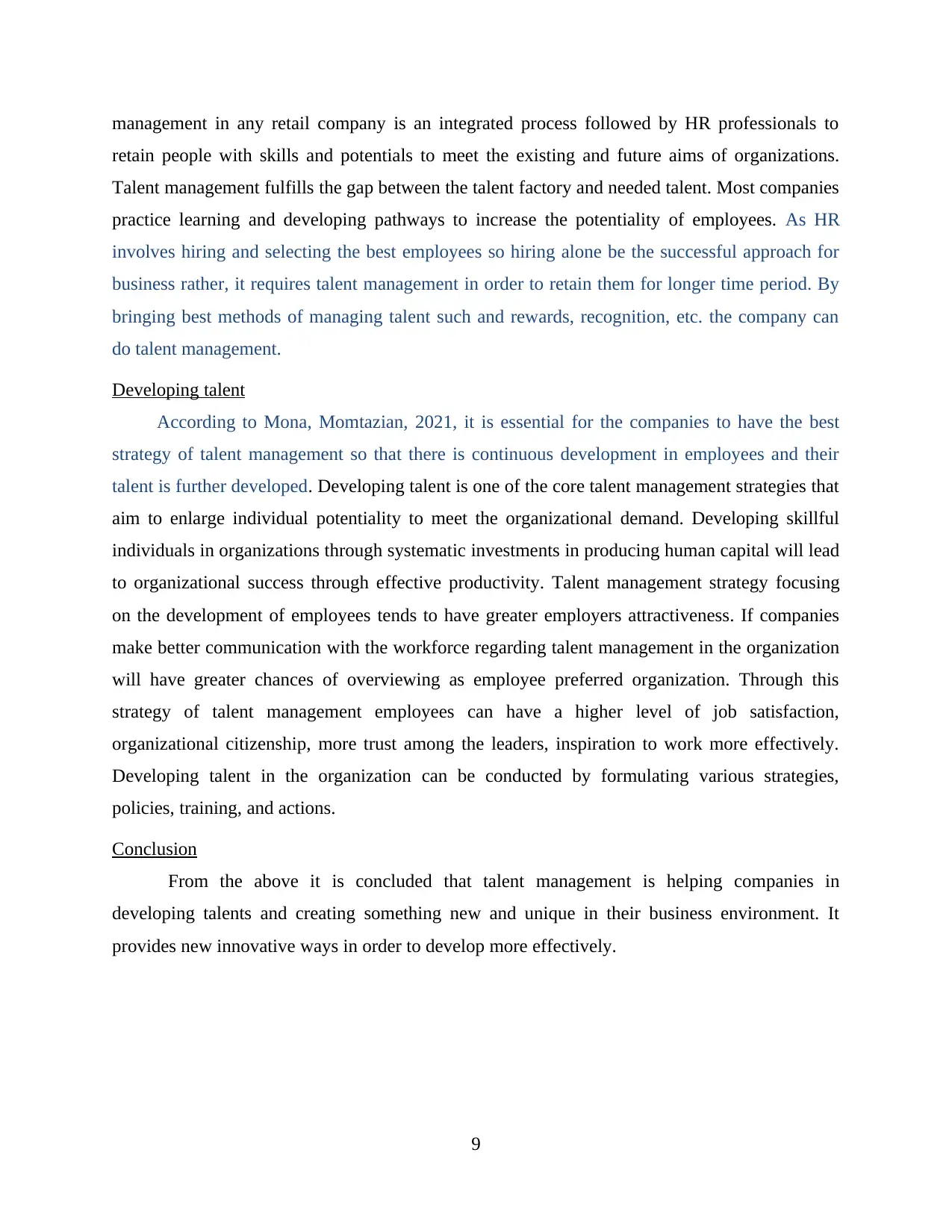
management in any retail company is an integrated process followed by HR professionals to
retain people with skills and potentials to meet the existing and future aims of organizations.
Talent management fulfills the gap between the talent factory and needed talent. Most companies
practice learning and developing pathways to increase the potentiality of employees. As HR
involves hiring and selecting the best employees so hiring alone be the successful approach for
business rather, it requires talent management in order to retain them for longer time period. By
bringing best methods of managing talent such and rewards, recognition, etc. the company can
do talent management.
Developing talent
According to Mona, Momtazian, 2021, it is essential for the companies to have the best
strategy of talent management so that there is continuous development in employees and their
talent is further developed. Developing talent is one of the core talent management strategies that
aim to enlarge individual potentiality to meet the organizational demand. Developing skillful
individuals in organizations through systematic investments in producing human capital will lead
to organizational success through effective productivity. Talent management strategy focusing
on the development of employees tends to have greater employers attractiveness. If companies
make better communication with the workforce regarding talent management in the organization
will have greater chances of overviewing as employee preferred organization. Through this
strategy of talent management employees can have a higher level of job satisfaction,
organizational citizenship, more trust among the leaders, inspiration to work more effectively.
Developing talent in the organization can be conducted by formulating various strategies,
policies, training, and actions.
Conclusion
From the above it is concluded that talent management is helping companies in
developing talents and creating something new and unique in their business environment. It
provides new innovative ways in order to develop more effectively.
9
retain people with skills and potentials to meet the existing and future aims of organizations.
Talent management fulfills the gap between the talent factory and needed talent. Most companies
practice learning and developing pathways to increase the potentiality of employees. As HR
involves hiring and selecting the best employees so hiring alone be the successful approach for
business rather, it requires talent management in order to retain them for longer time period. By
bringing best methods of managing talent such and rewards, recognition, etc. the company can
do talent management.
Developing talent
According to Mona, Momtazian, 2021, it is essential for the companies to have the best
strategy of talent management so that there is continuous development in employees and their
talent is further developed. Developing talent is one of the core talent management strategies that
aim to enlarge individual potentiality to meet the organizational demand. Developing skillful
individuals in organizations through systematic investments in producing human capital will lead
to organizational success through effective productivity. Talent management strategy focusing
on the development of employees tends to have greater employers attractiveness. If companies
make better communication with the workforce regarding talent management in the organization
will have greater chances of overviewing as employee preferred organization. Through this
strategy of talent management employees can have a higher level of job satisfaction,
organizational citizenship, more trust among the leaders, inspiration to work more effectively.
Developing talent in the organization can be conducted by formulating various strategies,
policies, training, and actions.
Conclusion
From the above it is concluded that talent management is helping companies in
developing talents and creating something new and unique in their business environment. It
provides new innovative ways in order to develop more effectively.
9
⊘ This is a preview!⊘
Do you want full access?
Subscribe today to unlock all pages.

Trusted by 1+ million students worldwide
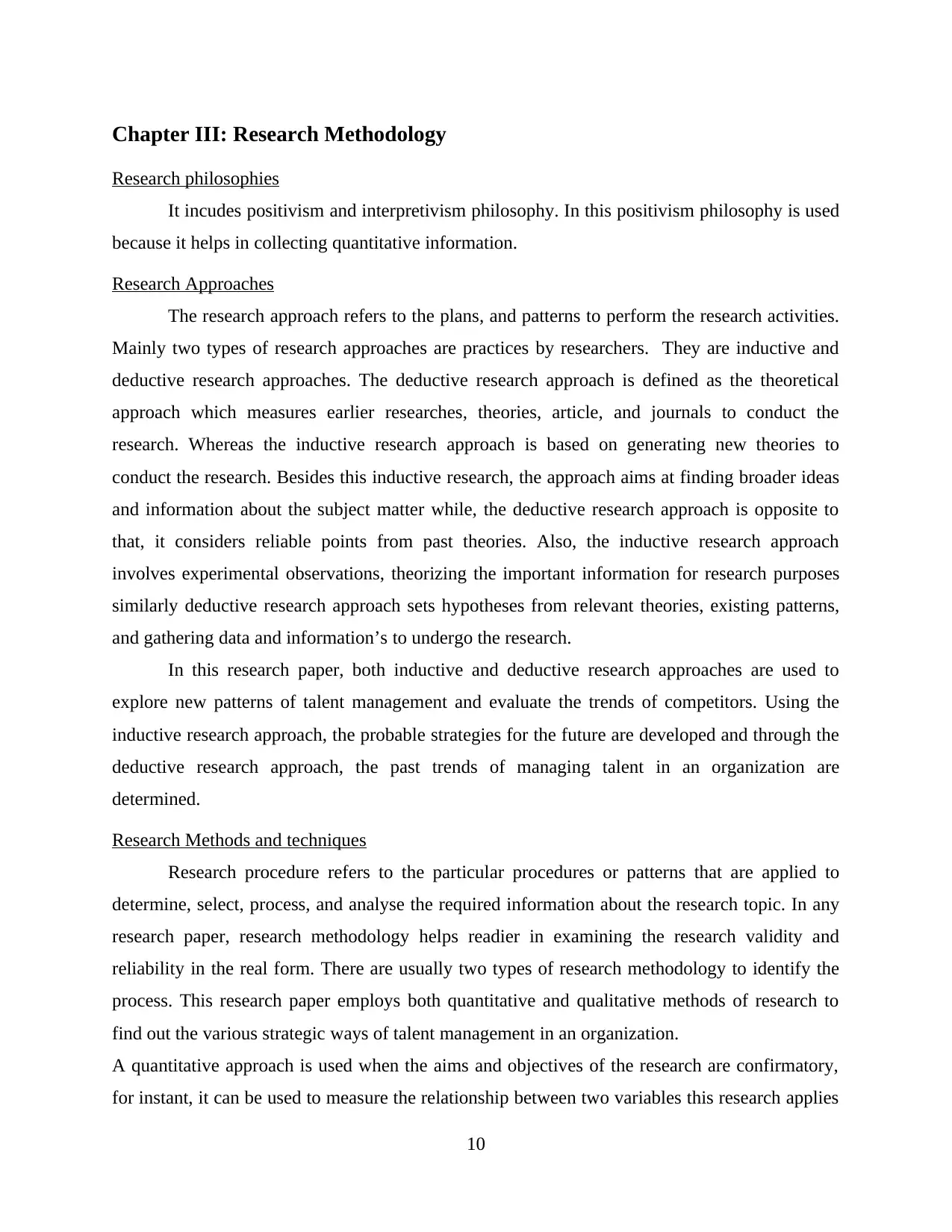
Chapter III: Research Methodology
Research philosophies
It incudes positivism and interpretivism philosophy. In this positivism philosophy is used
because it helps in collecting quantitative information.
Research Approaches
The research approach refers to the plans, and patterns to perform the research activities.
Mainly two types of research approaches are practices by researchers. They are inductive and
deductive research approaches. The deductive research approach is defined as the theoretical
approach which measures earlier researches, theories, article, and journals to conduct the
research. Whereas the inductive research approach is based on generating new theories to
conduct the research. Besides this inductive research, the approach aims at finding broader ideas
and information about the subject matter while, the deductive research approach is opposite to
that, it considers reliable points from past theories. Also, the inductive research approach
involves experimental observations, theorizing the important information for research purposes
similarly deductive research approach sets hypotheses from relevant theories, existing patterns,
and gathering data and information’s to undergo the research.
In this research paper, both inductive and deductive research approaches are used to
explore new patterns of talent management and evaluate the trends of competitors. Using the
inductive research approach, the probable strategies for the future are developed and through the
deductive research approach, the past trends of managing talent in an organization are
determined.
Research Methods and techniques
Research procedure refers to the particular procedures or patterns that are applied to
determine, select, process, and analyse the required information about the research topic. In any
research paper, research methodology helps readier in examining the research validity and
reliability in the real form. There are usually two types of research methodology to identify the
process. This research paper employs both quantitative and qualitative methods of research to
find out the various strategic ways of talent management in an organization.
A quantitative approach is used when the aims and objectives of the research are confirmatory,
for instant, it can be used to measure the relationship between two variables this research applies
10
Research philosophies
It incudes positivism and interpretivism philosophy. In this positivism philosophy is used
because it helps in collecting quantitative information.
Research Approaches
The research approach refers to the plans, and patterns to perform the research activities.
Mainly two types of research approaches are practices by researchers. They are inductive and
deductive research approaches. The deductive research approach is defined as the theoretical
approach which measures earlier researches, theories, article, and journals to conduct the
research. Whereas the inductive research approach is based on generating new theories to
conduct the research. Besides this inductive research, the approach aims at finding broader ideas
and information about the subject matter while, the deductive research approach is opposite to
that, it considers reliable points from past theories. Also, the inductive research approach
involves experimental observations, theorizing the important information for research purposes
similarly deductive research approach sets hypotheses from relevant theories, existing patterns,
and gathering data and information’s to undergo the research.
In this research paper, both inductive and deductive research approaches are used to
explore new patterns of talent management and evaluate the trends of competitors. Using the
inductive research approach, the probable strategies for the future are developed and through the
deductive research approach, the past trends of managing talent in an organization are
determined.
Research Methods and techniques
Research procedure refers to the particular procedures or patterns that are applied to
determine, select, process, and analyse the required information about the research topic. In any
research paper, research methodology helps readier in examining the research validity and
reliability in the real form. There are usually two types of research methodology to identify the
process. This research paper employs both quantitative and qualitative methods of research to
find out the various strategic ways of talent management in an organization.
A quantitative approach is used when the aims and objectives of the research are confirmatory,
for instant, it can be used to measure the relationship between two variables this research applies
10
Paraphrase This Document
Need a fresh take? Get an instant paraphrase of this document with our AI Paraphraser
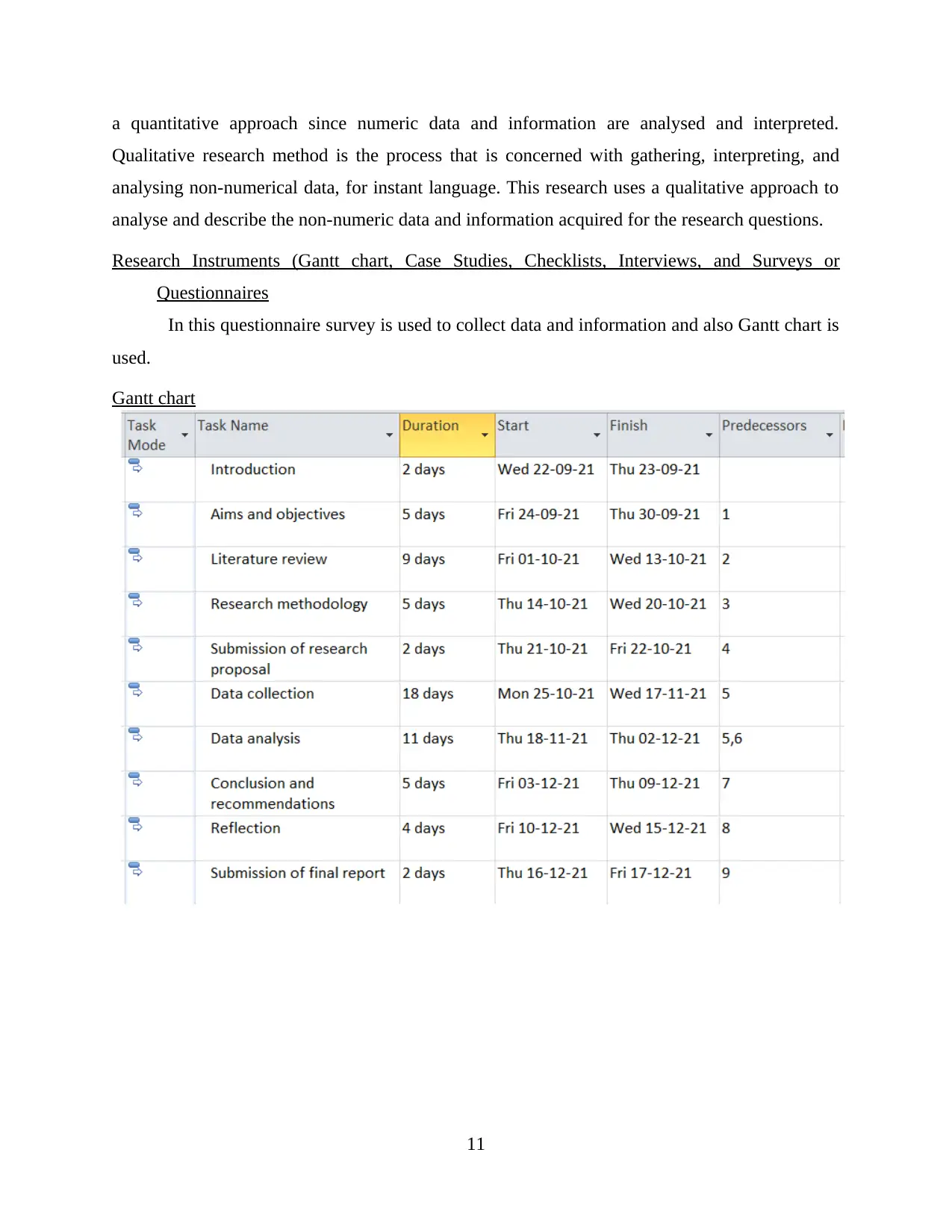
a quantitative approach since numeric data and information are analysed and interpreted.
Qualitative research method is the process that is concerned with gathering, interpreting, and
analysing non-numerical data, for instant language. This research uses a qualitative approach to
analyse and describe the non-numeric data and information acquired for the research questions.
Research Instruments (Gantt chart, Case Studies, Checklists, Interviews, and Surveys or
Questionnaires
In this questionnaire survey is used to collect data and information and also Gantt chart is
used.
Gantt chart
11
Qualitative research method is the process that is concerned with gathering, interpreting, and
analysing non-numerical data, for instant language. This research uses a qualitative approach to
analyse and describe the non-numeric data and information acquired for the research questions.
Research Instruments (Gantt chart, Case Studies, Checklists, Interviews, and Surveys or
Questionnaires
In this questionnaire survey is used to collect data and information and also Gantt chart is
used.
Gantt chart
11
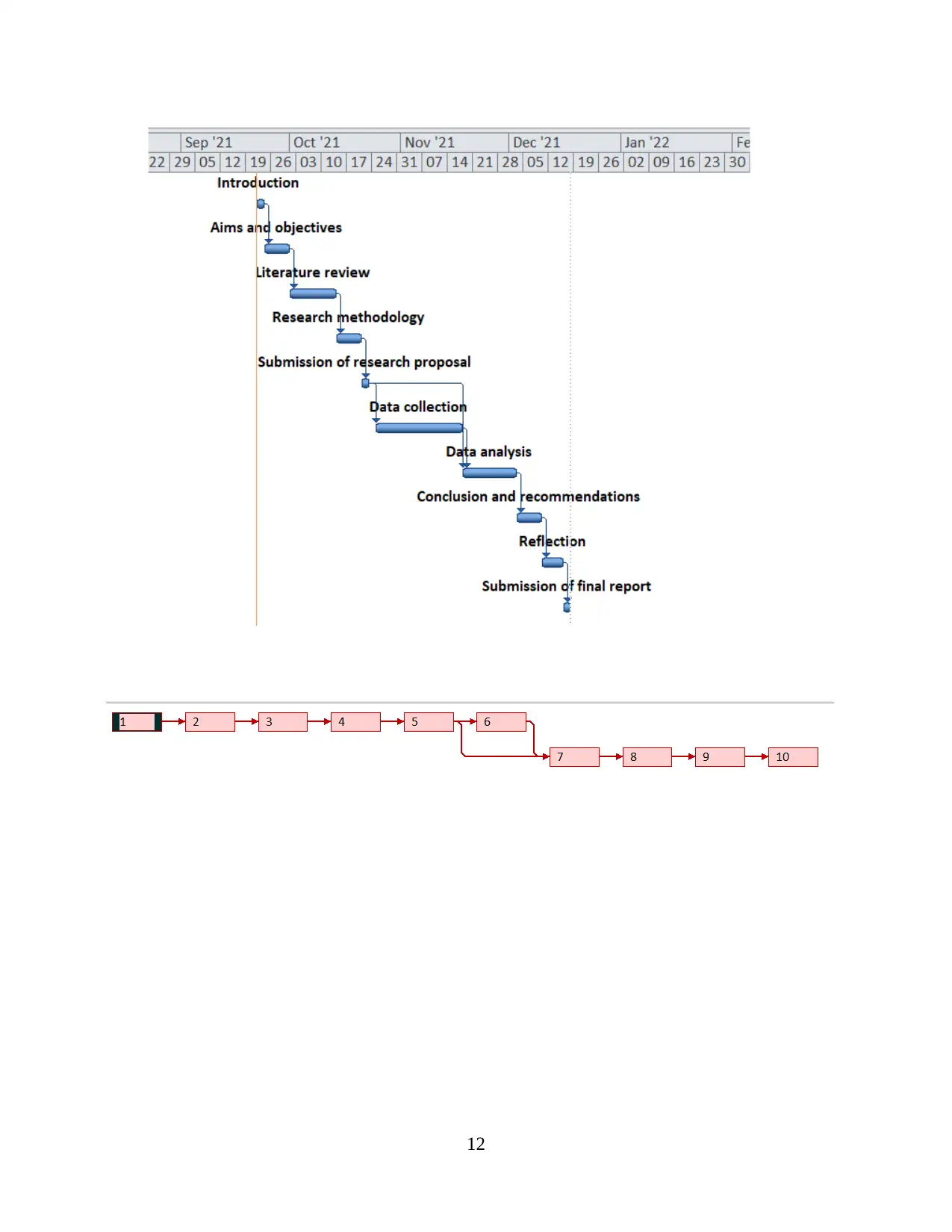
12
⊘ This is a preview!⊘
Do you want full access?
Subscribe today to unlock all pages.

Trusted by 1+ million students worldwide
1 out of 29
Related Documents
Your All-in-One AI-Powered Toolkit for Academic Success.
+13062052269
info@desklib.com
Available 24*7 on WhatsApp / Email
![[object Object]](/_next/static/media/star-bottom.7253800d.svg)
Unlock your academic potential
Copyright © 2020–2025 A2Z Services. All Rights Reserved. Developed and managed by ZUCOL.





